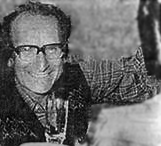César Milstein
César Milstein (born October 8, 1927 in Bahía Blanca , Argentina , † March 24, 2002 in Cambridge , England ) was an Argentine molecular biologist and immunologist .
Milstein grew up as the middle of three sons of a Jewish immigrant from Ukraine and a teacher in modest circumstances. Nevertheless, his parents made it possible for him to study chemistry at the University of Buenos Aires in 1945 , which he completed after a period of seven years in 1952 with a diploma and licentiate in chemistry. He then worked from 1952 to 1957 as a research assistant at the Institute of Biochemistry at the University of Buenos Aires. During his time as a politically active student, he met his future wife Celia, whom he married after graduation. After an interruption of studies during which he a. worked for a few months in a kibbutz in Israel , he received his doctorate in chemistry in 1957 at the medical school of his alma mater with a topic on the enzymatic kinetics of aldehyde dehydrogenase . From 1957 to 1963 he was a member of the Instituto Nacional de Microbiología in Buenos Aires, of which he was director between 1961 and 1963. In the meantime, he worked postdoktoral at the Department of Biochemistry at Darwin College of the University of Cambridge in England , where he is under the guidance of Malcolm Dixon with the properties of the enzyme phosphoglucomutase employed. This is how he met Frederick Sanger , in whose group he was active between 1960 and 1961. From 1963 Milstein belonged together with Sanger to the scientific staff of the newly founded Institute for Molecular Biology at the University of Cambridge. Sanger encouraged Milstein to shift his scientific focus to immunology . In 1983, Milstein became head of the Department of Protein and Nucleic Acid Chemistry at Cambridge.
Milstein devoted most of his scientific career to structural analysis of antibodies and the mechanisms that are responsible for the high diversity of these immunoglobulins . In this context, in 1975, together with Georges JF Köhler, he developed the hybridoma technique , in which the fusion of a myeloma cell line with a B lymphocyte enabled the production of large quantities of monoclonal antibodies . This discovery led to an enormous expansion of the use of antibodies in science and medicine. In 1984 he received the Nobel Prize in Physiology or Medicine for this work together with Niels Kaj Jerne and Georges JF Köhler . He has received numerous other awards, such as the Avery Landsteiner Prize in 1979 , the Robert Koch Prize in 1980 , the Wellcome Prize and the Louisa Gross Horwitz Prize , the Alfred P. Sloan, Jr. Prize in 1981 and a Gairdner Foundation International Award , 1982 the Royal Medal of the Royal Society , 1983 the Carlos J. Finlay Prize of UNESCO and 1984 the Albert Lasker Award for Basic Medical Research . In addition, he was elected a member of the German Academy of Sciences Leopoldina in 1982, a member of the National Academy of Sciences in 1981 and a member of the American Academy of Arts and Sciences in 1983.
César Milstein died at the age of 74 as a result of chronic heart failure. The asteroid (11776) Milstein was named after him on May 1, 2003.
literature
- César Milstein , in: Internationales Biographisches Archiv 24/2002 from June 3, 2002, in the Munzinger archive ( beginning of article freely available)
Web links
- Information from the Nobel Foundation on the 1984 award ceremony for César Milstein
Individual evidence
- ↑ Werner Köhler : Milstein, César. In: Werner E. Gerabek , Bernhard D. Haage, Gundolf Keil , Wolfgang Wegner (eds.): Enzyklopädie Medizingeschichte. De Gruyter, Berlin / New York 2005, ISBN 3-11-015714-4 , p. 992.
| personal data | |
|---|---|
| SURNAME | Milstein, César |
| BRIEF DESCRIPTION | Argentine molecular biologist |
| DATE OF BIRTH | October 8, 1927 |
| PLACE OF BIRTH | Bahía Blanca , Argentina |
| DATE OF DEATH | March 24, 2002 |
| Place of death | Cambridge , England |
